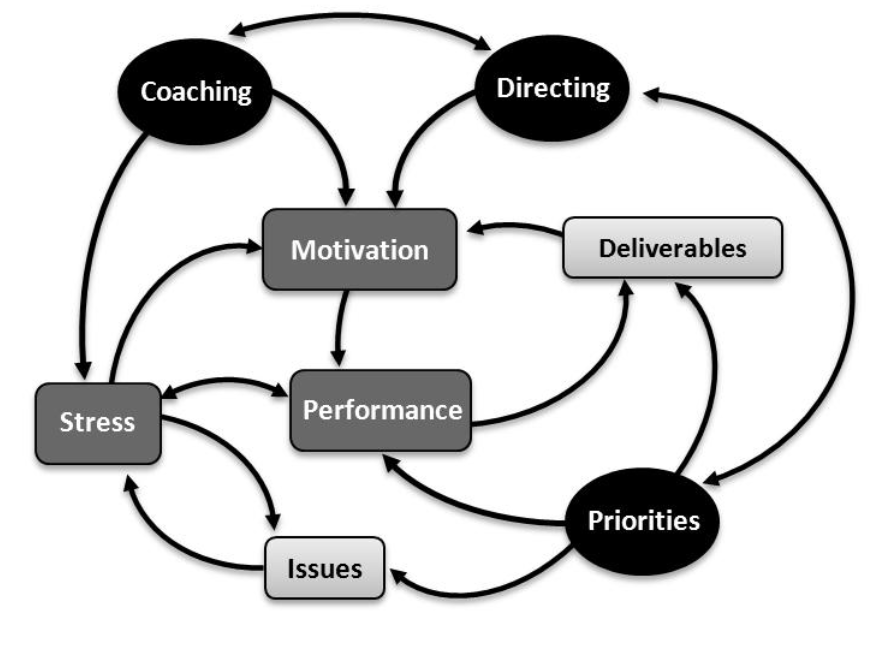About five years ago, my colleagues and I at The Regis Company created a process called impact mapping to drive more effective leadership development consulting techniques and help employees at all levels see and understand the big picture of the organization. We discovered that unless individuals and teams see the big picture and understand how the various functions or operations interconnect, their actions tend to be both self-serving and short-term in their impact.
These issues boil down to a lack of systems, critical thinking, and creative thinking. Failure to consider the entire system and its context often leads to diminishing results over time. Take, for example, understanding leadership dynamics.
The partial impact map below provides a simplistic view of the issues I had as a new manager. The map represents human responses (motivation, stress, and performance) to the application of certain leadership skills (coaching, directing, and prioritization).

The circles represent leadership skills, and the boxes represent human responses. The two lightly colored boxes are the results produced (issues, deliverables) by the application of skills developed through leadership development training programs, and human responses.
Let’s run some hypothetical business simulations. Morale is down, issues are up, and the team is falling behind on monthly objectives. As the leader, what do you do? Focus on results? How long can you sustain the team if results become the main focus? Instead, do you focus on simply doing what is best for your employees? Even well-intended actions can create undesirable results.
Let’s say you decide to invest your energy on coaching others, possibly with the guidance of some corporate leadership training. As a result, motivation improves, which causes performance to improve. Consequently, many deliverables are accomplished. As more gets done, your team feels good and motivation further improves. At some point, however, the level of performance is difficult to maintain, so issues start to surface. As the issues increase, so does stress, which increases the number of issues and decreases motivation.
When you realize these effects, you begin to split your energy between resolving issues and increasing motivation. This makes sense conceptually, but when your boss calls to express concern that you missed three of your five deliverables, you decide it’s time to take matters into your own hands and start directing others more diligently. This crazy cycle repeats, rendering those leadership tools, tips, and tricks impractical.
Each of these choices requires leaders to leverage both the Core Abilities and the Value Skills. The Core Abilities equip you to assess the situation and the Value Skills enable you to take action. The Core Abilities push you to explore and understand the underlying dynamics. Staying at the surface level by reacting to events and trying to fix issues using processes or linear thinking merely creates crazy cycles. These cycles receive momentum from heroic efforts to apply quick fixes.
An alternative approach is to recognize the patterns and underlying structures that contribute to the system’s behavior and implement a well-designed and immersive leadership development training program. This changes the focus from quick fixes or attributing failure to others to finding ways to improve the system.
This new way of thinking forms a framework for developing how-to-think workers.
Actually creating how-to-think workers is easier said than done, however. For instance, Core Abilities can’t be taught in isolation. They can be introduced or reinforced individually, but to ensure they take root, they must be applied together in an actual or a simulated environment as part of an effective leadership training program. They are so intimately connected that what is learned at the individual topic level cannot be easily applied when people need to flow between the abilities as a situation evolves. Michael Vaughan is the CEO of The Regis Company, a global provider of business simulations and experiential learning programs. Michael is the author of the books The Thinking Effect: Rethinking Thinking to Create Great Leaders and the New Value Worker and The End of Training: How Business Simulations Are Reshaping Business.